From the patio of her house, Emelina has her eyes fixed on the sea that has given her everything but is about to take it away. Their house is destroyed in half and lumps of sand try to dampen the intensity of the arrival of the waves, but they are less and less successful. From there, you can only observe.
What were kilometers of sand before reaching the water have become a few meters that disappear as soon as the wind hits. That is why the women and some men of Las Barrancas have organized themselves to find a solution to this loss of beaches and the consequences it brings for the fishing village, such as seeking new forms of income.
Emelina Castellanos, like many local people, has been living in Las Barrancas, in the municipality of Alvarado, Veracruz, for 42 years. The sea gave him the opportunity to watch his son and daughter grow up. Her husband is a fisherman like most people in the community. All there, where now the beach is about to be lost and several houses have been taken or damaged.
Now just look at that couple of meters of sand that disappears at night and the sea that turns violent with the wind. This is how it happened one night in October 2022, around 2 in the morning Emelina and her husband woke up to the loud pounding of the water and went out to see how the sacks had been overcome and the foundations of their house were being destroyed.
That night they didn't sleep, they spent it under sail from their neighbor's yard seeing if it was necessary to evacuate the house, their only asset, with their pregnant daughter whom they tried not to frighten with what was happening.
“My husband bought like 400 or 300 sacks. It cost us 5 pesos each bag and there he bought three sacks of a thousand pesos each bag, to at least cushion a little, but we haven't had any kind of help (...) we have nowhere to go and here we are, my husband wants to buy more bags to put there, but this thing is very ugly, very sad, very critical and unfortunately the government doesn't see where you are,” she said from home.
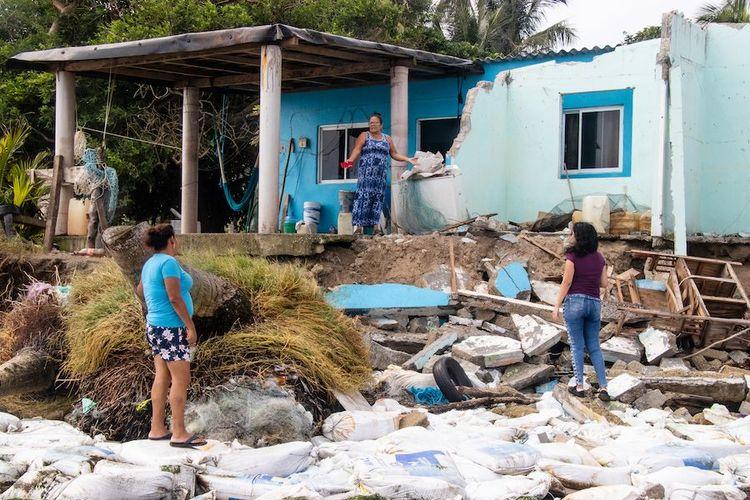
Emelina Castellanos talks with two neighbors on the part of her terrace that hasn't been knocked down by the sea. Photo: Iván Sánchez
This' loss' of beaches that have experienced over the years is a phenomenon called coastal erosion that is due to climate change, natural phenomena such as norths or hurricanes and, of course, to human hands such as the construction of infrastructure at various points.
Until 2021, the Secretariat of Civil Protection had registered 71.7 km of coastal erosion in Alvarado and is the municipality of the state most affected by this phenomenon, according to the document Civil Protection Recommendations addressed to municipal authorities for erosion/sedimentation of coastal areas, carried out by the Government of the State of Veracruz.
Official data - based on INEGI orthophotographic analysis from the 90s and satellite images from 2012 to 2016 - also reveal that in the state of Veracruz, 77 percent of the coastline has gained ground to the sea and the rest, 33 percent, has the opposite effect. This is where the tide is reaching houses and buildings such as in Las Barrancas.
Alvarado is the state municipality most affected by this phenomenon, followed by Tampico Alto and Tecolutla according to the document Civil Protection Recommendations addressed to municipal authorities for erosion/sedimentation of coastal areas, prepared by the Government of the State of Veracruz.
Although some houses have already been affected, Civil Protection does not have a census of the damage and its Recommendations document does not include a plan to solve the damage suffered by the inhabitants, according to the head of Guadalupe Osorno.
In fact, the official acknowledged that the agency in her charge “has to make the corresponding visit” because they do not yet know “if there are specific technical recommendations for houses that can sometimes be solved with any issue that could be a palliative”.
If there is no “palliative” -said the official- “because we would have to seek relocation, relocation involves work between two levels of government, the municipalities and the State”, which involves donations of land from the municipality to the affected families.
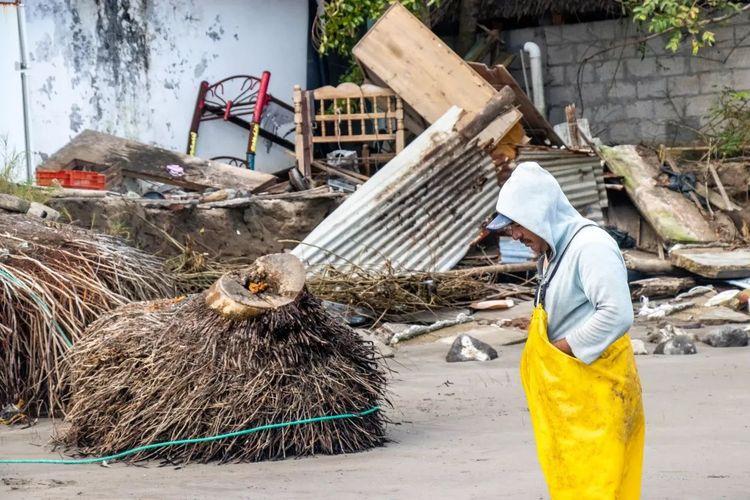
Inhabitants of Las Barrancas on tours of the surface gained by the sea where their entire properties used to be. Photo: Iván Sánchez.
Alvarado is a municipality in the area of the Veracruz Basin, mostly coastal and although it has been heavily affected by erosion, no town reflects it more than Las Barrancas, a community of just 350 inhabitants that is located between the beach and the mangroves and where fishing carries in its blood almost as much as the smell of the sea that fills the environment.
That's why 10 years ago, Nancy Ochoa and two other women from nearby communities began fighting to try to get someone to look at what was happening and reach out to them. At that time they were municipal agents, but later they became a civil association bringing together different women from the area, who have worked to try to rescue Las Barrancas and seek solutions to the problems they are experiencing.
But while governments have promised, they haven't delivered. In fact, on April 2, 2014, the then governor, Javier Duarte de Ochoa, inaugurated a breakwater (a structure that seeks to protect the coast and divert currents) in a nearby town and announced that the project included eight in total. One of them was for Las Barrancas, but it never arrived.
The project for the breakwater in that town was tendered, awarded and money was given, according to the Supervisory Authority of the State of Veracruz in its 2016 Public Account, which states that the project was “unfinished” so it left it to be audited for the following year, although it was no longer carried out.
In addition, in June 2016, the extinct Papaloapan Development Council accepted the proposal for 2 million 944,993 pesos from the company Cocowarris México SA de CV to build a breakwater project specifically in the Las Barrancas area. Nothing was heard from him again and the Council was disbanded by the administration of the State Government.
The Secretary of Civil Protection stated, in a telephone interview in December 2022, that the loss of beaches is due to a natural phenomenon, but also to constructions, so at this time there is no project that she is aware of generating new breakwaters and they do not know what happened to those of past administrations.
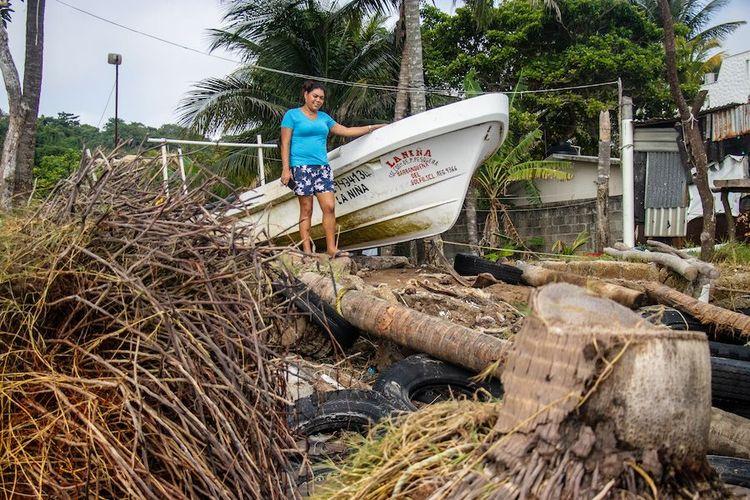
Nancy Ochoa, on a tour of the area affected by the tides in the community of Las Barrancas. Photo: Iván Sánchez.
Organization to ask for help
From the beach, a group of fishermen observe two destroyed houses left by the last cold front; the remains of some furniture are revealed, the refrigerator, a table and some dishes, a wardrobe and the remains of a bed in another. Its inhabitants went that night to live with relatives, because there was nothing left of their house.
They tell about that breakwater they promised them and that some of the inhabitants see as the only solution, while others and others believe that they should do new studies to find out what is happening.
But they all agree that the problem of beach loss in Las Barrancas worsened in 2014 when they built that breakwater in the nearby community, which Duarte de Ochoa boasted so much.
Jacobo Santander, a researcher at the Technological Institute of Boca del Rio and who has been working closely with residents of Las Barrancas, stated that coastal erosion is the loss of the beach caused by natural phenomena such as northerners or hurricanes.
“When we talk about coastal erosion, that's it, we're talking about a loss of coastline, right? So when we talk about coastal erosion, it's this loss of the beach, that loss of the coast due to different phenomena, here we're attributing it mostly, let's say, to meteors like hurricanes, to meteors like well, not meteors, yes, like norths or phenomena like norths,” he said.
“But erosion is also caused by the lack of sediment supply. So if you're losing the beach, it could be because the sea level is rising, it could be because they're building a port for you, they're building coastal infrastructure for you and those physical structures are modifying your currents and modifying your sediment distribution,” he said.
For the inhabitants of Las Barrancas, the construction of infrastructure at sea is precisely the reason that coastal erosion has advanced so rapidly. Although they know that climate change affects them and that they have lost ground over the years, they think that the construction of the breakwater in the nearby community (Mata de Uva), the expansion of the Heroic Naval Military School and the new Port of Veracruz are also the cause of everything accelerating. These works were carried out in 2014 and since then many meters of beach have been lost.
Santander pointed out that it is not possible to say how much these works affected since there is a lack of studies to determine it, however, it is possible that some have had a direct impact since where infrastructure is placed it generates changes in currents and therefore may cause some beaches to disappear more quickly.
Nancy and her colleagues have walked, attended forums, carried out procedures before all instances, presented their situation in various spaces and even have invitations abroad. But none of that has made the authorities look back at them.
Even on one occasion, he said, Governor Cuitláhuac García Jiménez told them that what they needed were life jackets. The town took it as a mockery. Even so, they went looking for them with the hope that they could talk to someone who would take them seriously, but they didn't get an answer or vests.
A fishing town without a beach
Several men placed around a boat push it every time three scream, while a large trunk rolls it to a terrain that is a few centimeters higher. Some houses later, something similar happens, but supported by a van that pulls the fishermen's heavy tool from the front.
That scene is repeated every day. They are a fishing town that has nowhere to put their boats because as soon as the tide rises a little, the beach disappears and the waves cause them to hit, causing extensive damage.
This has even meant that there are nights when they have to get up to go save the boats, the little heritage they have, in the middle of the water that is already starting to take them away.
That is why the solution they have found is to make the effort to climb it to the land that is a little higher and invest at least 30 minutes to leave them accommodated in those spaces. Some, even, must rent on land that they have considered to have the lowest risk.
“It's the only thing we have and the sea is destroying it and the hardest thing is that high-ranking authorities just ignore the high-ranking authorities,” said Carlos Manuel Tello, who has dedicated his life to fishing, learned from his father and the latter in turn from his father, but now he didn't want to pass on the job to his children because he is aware that soon there will be no beach to do it.
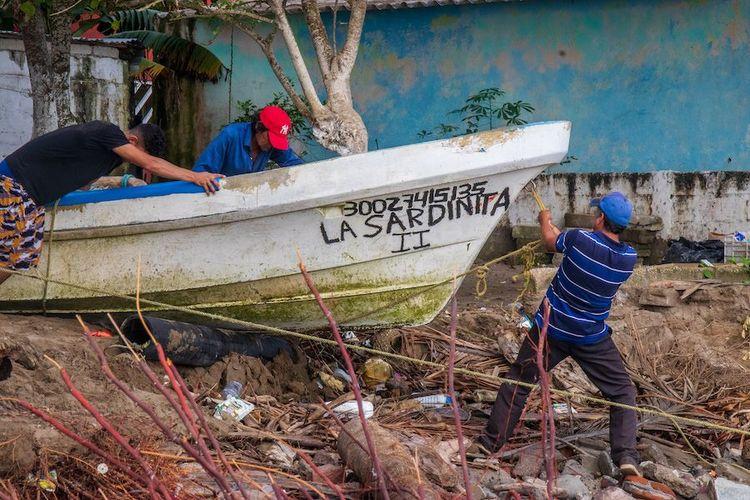
Fishermen from Las Barrancas, in the task of lowering the boat from a level where they leave it so as not to be hit by the tide. Photo: Iván Sánchez.
Some researchers have come to Las Barrancas to learn about the situation, to study climate change, coastal erosion and the way in which its inhabitants are experiencing the effects. The members of the association have come together to work together and have encouraged the rest of the community to participate, trying to mitigate the problems.
These researchers have proposed projects such as planting vegetation on the beach to prevent the sea from continuing to carry away sand and what has worked elsewhere, but they are discarded because they are not viable for the area.
Santander said that coastal erosion is multifactorial because natural phenomena, climate change, mangrove pollution and the construction of structures affect. Therefore, actions such as the breakwater that they have promised to the community could be a palliative (if done with studies that review what the real impact will be both there and elsewhere) but in the long run it will not be a solution.
There, the community has also understood that the mangrove behind their houses can help because it 'carries' sediments into the sea that it brings in from other parts. But due to the high pollution it has and the poor conditions in which it is, currently, the mangrove is not doing that function.
That is the reason why they set themselves the goal of trying to rescue it and even to take advantage of it economically. They have met with people from other regions where they have managed to do similar activities and began cleaning days removing those wastes that, due to ignorance of its consequences, threw into the water.
Nancy said that they are looking for the mangrove forest to be used for sightseeing tours in the area, so that people can come to observe the richness of birds and species they have, but also to the beach. In addition, with that they are trying to mitigate, even a little, the loss of a beach that they know they will not recover.
Because they know that those years will never return, in which Nancy's father narrated, he built palapas to take advantage of the arrival of tourists during the vacation season and rented them while the women of the area made additional money frying the fish that those who arrived asked for them.
The space for Nancy's father's palapas gradually disappeared and in recent years, the remaining stretch became a place to put tires to prevent water from reaching his land all at once. Thus, at 80 years old, he is fighting a battle against the sea that he does not seem to win, a battle against the place to which he owes everything he is and from which he never wanted to go, no matter how many other professions offered him: his thing is to be a fisherman.
But now being a fisherman in Las Barrancas is difficult, says Nancy, who is also the leader of a cooperative of fishermen and women, because there is nowhere to leave the boats and climate change has caused changes in species. In addition, tourism no longer arrives because they no longer have beaches.
That is why alternatives such as generating ecotourism in the mangrove can be an option for earning income in the community. So is the Las Bonitas Primary Processing Plant, another of the efforts they have as a community to face their problems because it was created by women and which processes the fish generated by the cooperative making minilla and ceviche to package and sell.
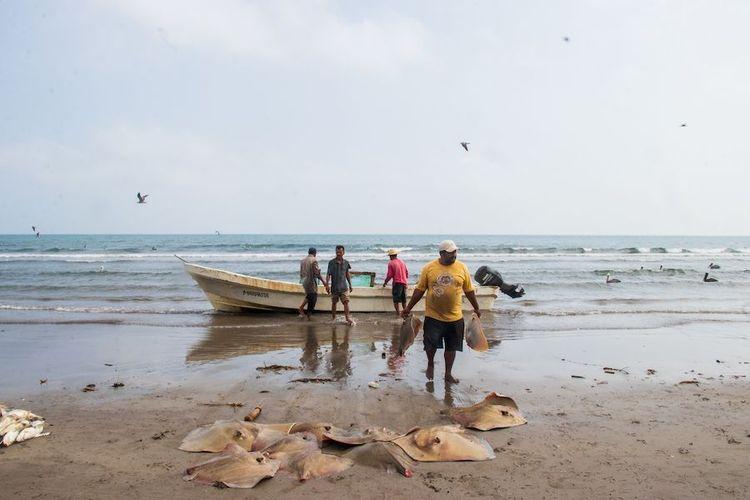
Fishermen from Las Barrancas arrive ashore after a day of work. Photo: Iván Sánchez.
“As far as the sea went”
Recently, they said, a municipal official arrived and told them that their problem is that they are in the federal zone because they are in that 20-meter strip known as the Federal Maritime Terrestrial Zone, where it cannot be built. The only thing it achieved was the indignation of the people because their land and houses are private property, purchased many years ago, to which that federal strip reached them because the sea reached them and now they are having serious problems.
“Wherever you see that pelican, that's where the beach went”, “we could leave the boats there, see where that one comes from”, “look where you can see that stain”, is a constant of fishermen standing in front of the sea.
From the seashore, they miss those years when the beach occupied large tracts of land, when walking or driving along the beach between nearby towns was an everyday thing, when that place where it is now only water served as lanes for horse racing, when tourists arrived and left them some money, when they didn't have to live in fear that the water would wash away their homes any given night or when accommodating their boats after returning from fishing was a daily challenge.
From those times, all that remains is to think about them, while they beg for help of some kind, because although they are aware that climate change and rising sea levels will cause Las Barrancas to cease to exist at some point. They accuse that the works that the government itself has carried out have accelerated the process and now that same government must do something to lend them a hand. From those times, there are only a few old images that they upload to their phones and show at the slightest provocation and the memories that they treasure and narrate without hesitation while uncertainty reigns and they try to get used to the new life.
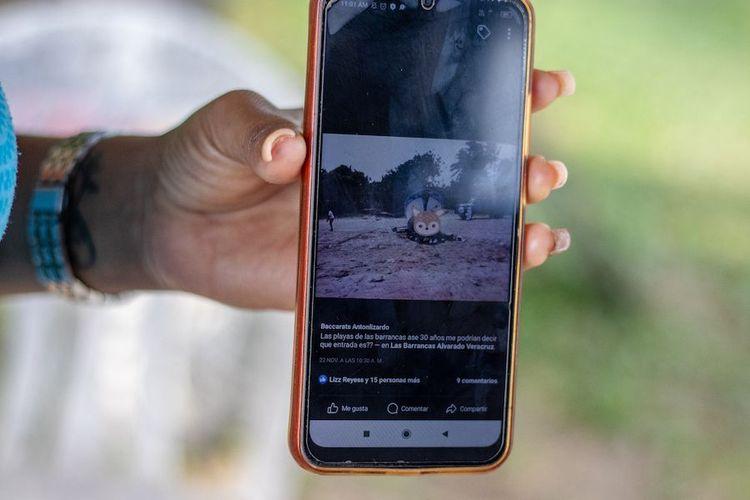
Las Barrancas, 30 years ago, in a photo saved by Nancy on her phone. Photo: Iván Sánchez.
* This work was supported by the Marine Journalism Network (Repemar), promoted by Causa Natura with the help of the Earth Journalism Network of Internews.
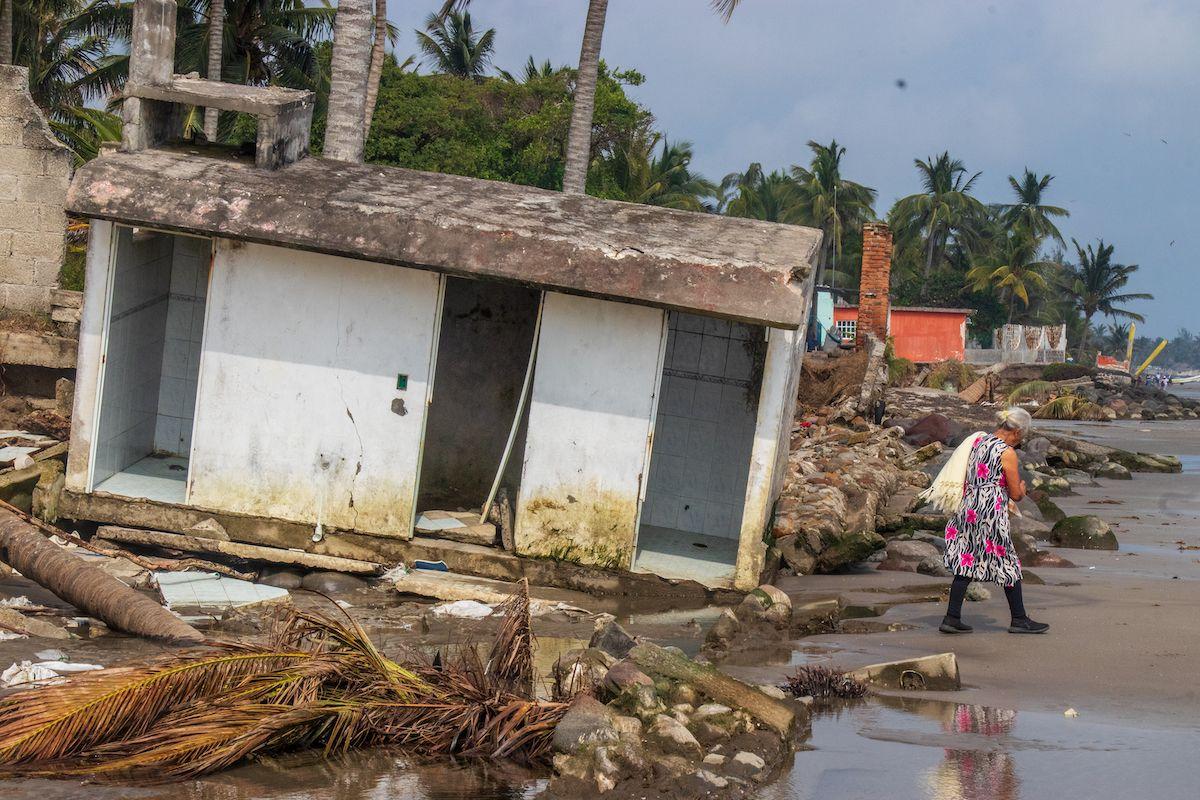


Comentarios (0)